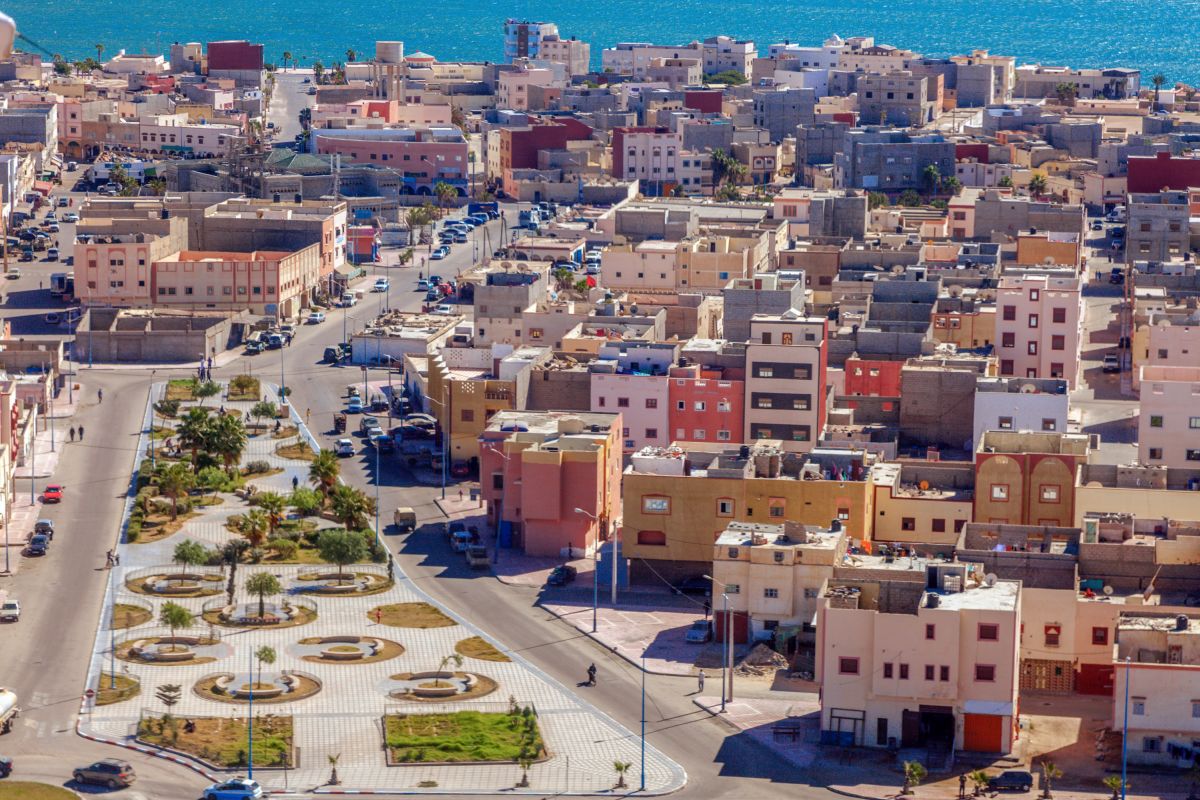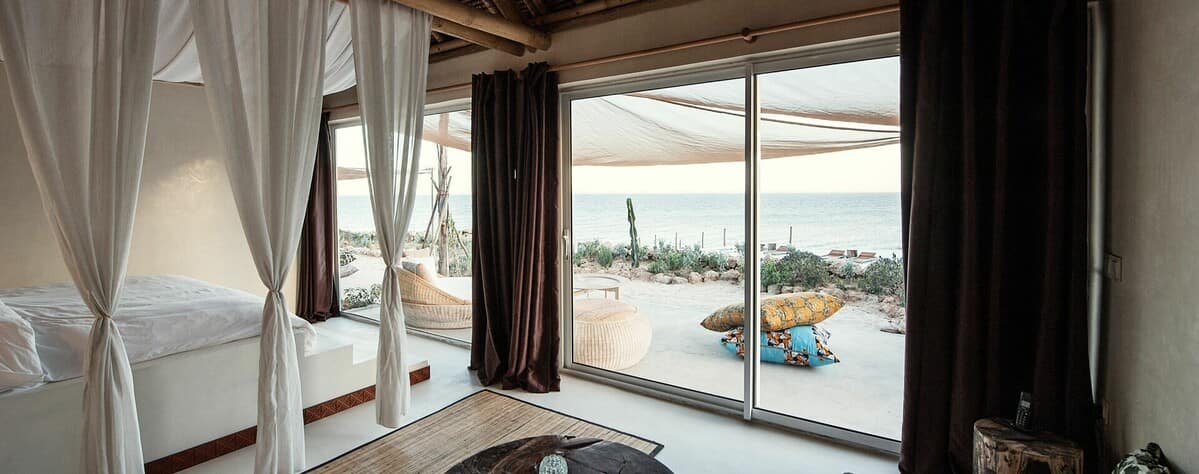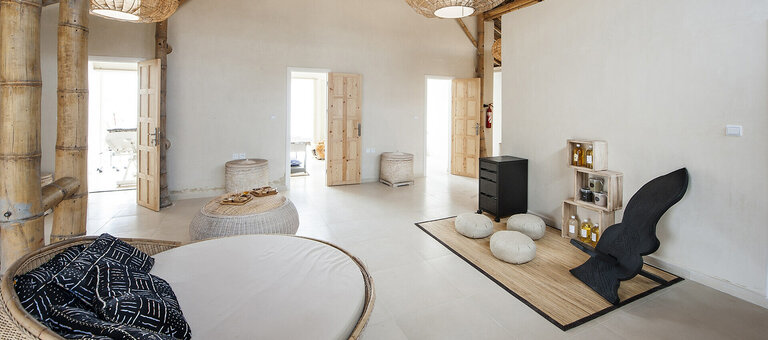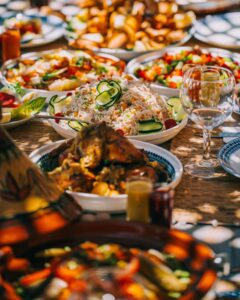
Kitesurf DownWind in Dakhla over 300Kms

Dakhla Kitesurf videos: the best rides in pictures
A medium-sized town nestling in southern Morocco, Dakhla is often nicknamed the oasis between the sands of the Sahara and the Atlantic. This Moroccan end of the world, with its contrasting landscapes, knows how to be charming. Indeed, the meeting of sea and desert is a breathtaking sight. So it’s hardly surprising that an increasing number of travellers are succumbing to the charms of the peninsula, making it a highly sought-after destination. As for its people, famous for their carefully preserved traditions, they will give you the warmest of welcomes. A change of scenery is guaranteed, but you can also expect total cultural immersion.
Dakhla is strategically located to the south of Agadir (almost 1,200 kilometres away). In the 1920s, the town, then known as Villa Cisneros, was one of the obligatory airmail stops on the way to Dakar. Thanks to a harmonious blend of sea and desert, with long beaches of golden and white sand, not to mention year-round sunshine, the Dakhla Oued Eddahab region is now one of the most important tourist sites in the world.Contenus de la page
Origins of the town and place names
الداخلة is the name of the town in Arabic. In Berber, here is its name: ⴷⴷⴰⵅⵍⴰ. However, there are also those who call it Ed-Daḵla.. At the time when the Spanish took control of Sahara, the locality was called Villa Cisneros. Dakhla owes its name to the Cardinal, a religious reformer by the name of Francisco Jiménez de Cisneros.
Geography: Where is Dakhla?
Localization
Lost between the Western Sahara desert and the clear waters of the Atlantic, Dakhla is neither a rock nor a cape. It is a peninsula of infinite charm on the Atlantic coast. This city beaten by the waves of Dakhla Bay is located around 30 km from the Tropic of Cancer. It shares the same latitudes as Havana. Less than 700 km from Laâyoune lies this little Moroccan paradise. Nearby cities include Canton and Hawaii, while the Mauritanian border is just 370 km away. This strategic geographical position has attracted thousands of tourists every year. 
Climate
A temperate desert climate dominates the weather in Dakhla. This climatic condition is responsible for the relatively warm temperatures in the interior of the country. In fact, it’s not uncommon to record temperatures in excess of 48°C in summer. Fortunately, the coast is cooler, due to the rather cold ocean current from the Canaries. In Dakhla, average temperatures generally fluctuate between 22 and 27°C. For your information, the town’s annual rainfall is spread over around ten days a year. The rain gauge records around 33 mm of precipitation during the rainy season.
History of Dakhla
Villa Cisneros
Dakhla is a town with a tumultuous past, particularly during the period of the Spanish Sahara. Until the 14th century, Dakhla was a desert inhabited only by fishermen. Saharan tribes from the surrounding villages came to nomadise in this almost wild village. Then, the first Spanish settlers came to take over the land, starting the construction of the town. This movement gave rise to Villa Cisneros, which was the name of Dakhla for a very long time, in homage to Francisco Jiménez de Cisneros. In 1976, the Spanish settlers left the Western Sahara in which the town is located. But this was far from the beginning of its independence. On the contrary, the territory was shared by Morocco and Mauritania. For several years, the town was the subject of political, economic and diplomatic conflicts between the Polisario Front and the Moroccans. Even after the ceasefire announced by the UN in 1991, the situation has not been resolved. Nevertheless, this territorial dispute is not a blocking factor for the town’s tourist activities, which, against all expectations, have expanded. In fact, the number of holidaymakers coming to Dakhla has been rising steadily since 2008. As a result, tourism is one of the mainstays of the town’s economy. https://youtu.be/Lt6zBY4CzsA
Economy
The local economy is definitely based on tourism. Given the growing number of travellers who come here every year, the local inhabitants practically live off this activity. Less than 20 years ago, Dakhla was unknown to international tourists. Then its reputation spread to the four corners of the globe. Dakhla’s exceptional postcard-perfect setting of desert and sea is the talk of the town. Tourists flocked here en masse, giving rise to flourishing investment. As a result, new infrastructure has sprung up all over the place. However, the city’s maritime treasures are also a major economic resource. Dakhla is the leading supplier of seafood products in the country. And for some years now, it has been exporting its maritime riches to Europe and certain Asian countries.
Tourism
Dakhla has 667km of fine sandy coastline and 400km² of bay. The town’s natural and cultural wealth makes it an ideal location for all kinds of tourism projects. Holidaymakers looking for farniente breaks will love a destination that promises miles of beaches, while culture-loving tourists will love tangling with the locals and sharing their daily lives. Like the natural beauty of the peninsula, tourist establishments are springing up all over Dakhla, testifying to the dynamism of the sector. Hotels, surf camps and seaside resorts all contribute to the development of this activity in the town. In fact, for almost ten years now, Dakhla has been an essential meeting place for kitesurfers and windsurfers from all over the world.
Luxury holidays offer an extraordinary experience!

Agriculture
Travelling to Dakhla means setting off to conquer a multi-faceted destination. This peninsula is famous for many things, but above all for its melons and cherry tomatoes. For the record, agriculture is the second most important sector for employment in the town. What’s more, the agricultural sector is benefiting from a new lease of life thanks to the seawater desalination project. Attracted by the boom in this sector, many investors are choosing the region. For several years now, raw materials processing projects have been set up in Dakhla. This is creating new prospects for local young people. Nevertheless, the cultivation of cherry tomatoes for export remains the mainstay of the agricultural sector, with almost 44,000 tonnes of tomatoes produced each year.
Breeding
In Dakhla, the pride of place is given to camel farming. In fact, camel herds produce around 5,000 litres a year. Camels are emblematic of the region, and form a strong pillar of the local economy. However, there is no denying the great diversity of livestock farming on the peninsula. Sheep, goats, cattle and, most surprising of all, ostriches. Hundreds of non-volatile birds are kept to supply the town and surrounding areas with meat.
Fishing
The growth of surfcasting fishing in Dakhla is spectacular. As you will have gathered, this peninsula is particularly spoiled by Mother Nature when it comes to underwater riches. The finest fish on the continent are caught here. For tourists, this is an exciting activity that will spice up their stay. As for the locals, fishing is a large part of their livelihood.
How do I get to Dakhla?
Airport
When you go on holiday, the last thing you want to do is spend hours in transport. Fortunately, Dakhla is well served by airlines, so you can take advantage of both international and domestic flights. Its airport is linked to that of Mohamed V-Nouasser de Blanca, with Royal Air Maroc offering daily flights. But you can also fly from Las Palmas de Gran Canaria. Several airlines operate this route.
Bus station
If you prefer to take the road, the bus station at Hay Nahda is the best place to go. The transport companies that use this station provide services between Dakhla and the major towns around it, including Agadir, Western Sahara and Morocco.
Daily life in Dakhla
Culture
Dakhla is a city rich in culture. Various festivities punctuate the daily life of its inhabitants, the most famous of which is the Sea and Desert Festival. Since 2007, the town, and indeed the whole country, has been giving prominence to this event. Dakhla is a water sports paradise, so the festival is enlivened by a host of sporting events. For almost a week, the peninsula is in celebration. Thousands of national and international visitors come to this cultural event every year. Some tourists even make sure to plan their stay around the date announced for the next edition of the Sea and Desert Festival. It’s an experience you should have at least once in your life. 
Local specialities, discover typical dishes
Dakhla has always been a much sought-after town. First by settlers, then by kite-surfers and travellers keen on gourmet getaways. Here, cooking is a women’s affair, with typical recipes handed down from mother to daughter. Moroccan cuisine reflects its eventful past, with the different inhabitants who have settled here. On the table, you’ll find spices from the Arabs, tagine from the Berbers, dates from the Bedouins and olive oil from the Moors, all washed down with English tea. Like the country’s history, its cuisine is complex. What a treat for the taste buds!
Moroccan gastronomy in the spotlight
The Couscous
Fridays are all about couscous. Like a ritual, this dish is served alongside other typical local dishes such as rfissa, keftas and tanjia. On your plate, you’ll find cereals and chickpeas topped with fats. Traditionally, couscous did not contain any meat, as legumes fill the bill nicely. But no two recipes are ever the same, because over time, families have created their own formulas. Today, the dish is served with meat. One thing is for sure, you must try this marvel when you visit Dakhla.
Moroccan entries
The people of Dakhla are great salad aficionados. Indeed, Moroccan starters, generally served at the beginning of the meal, consist of tomato and onion salads, most often with peppers and coriander or cumin. Special mention should be made of the méchouia salad and the olive salad (meslalla) that traditional restaurants never fail to present to gourmet travellers. Imagine a colourful and deliciously fragrant table.
The main course
Moroccans are very fond of soup, which is served in most of the small restaurants in Dakhla. Nevertheless, the tajine remains the most popular dish, generally eaten as a main course. It is prepared with vegetables and meat, but the variety of versions means that the taste of tagine is not the same throughout Morocco. Some families keep to the traditional recipe based on vegetables, fish and meat, while star chefs, keen to showcase their culinary talent, invite other ingredients including chicken, walnuts, prunes and even apricots. Tagines are always spicy, even if they are not very hot. More often than not, the dish is slightly sweet. An explosion of flavours guaranteed!
The patisserie
Think again! Moroccans don’t just eat meat and vegetables sprinkled with all sorts of spices. In Dakhla, pastry chefs compete in their know-how and creativity to create cakes. It’s impossible not to mention the emblematic chebakia when talking about Moroccan pastries. Most often served with tea, this delicacy is never absent during the holy month of Ramadan. In any case, gazelle horns, briouates, ghoriba and kaak are among the must-tries on a culinary trip to Dakhla.
The drinks
A festive meal worthy of the name is never complete without the right drinks to wash it down. Don’t worry, you’re drinking healthily with the exotic-coloured fruit juices on offer in many stalls. In fact, soft drinks and fruit juices are the country’s main drinks, bearing in mind that the vast majority of small restaurants are not allowed to sell alcohol (for lack of a licence). Beer, on the other hand, offers a wide choice. Flag special, stork and the famous Heineken – the choice is yours. Some regions also produce wine, ideal with meals. Tea is also very popular in Dakhla and throughout Morocco.
Things you need to know about Dakhla
What is the name of the country that was the colony of the town of Dakhla?
- Administration: Western Sahara under Moroccan rule
- Province: De Ed Dahab
- Region: Dakhla-Oued Ed Dahab
Why is Morocco called Morocco?
In an oasis at the foot of the High Atlas, the leader of the Almoravids founded Marrakech, the second imperial city of Morocco, which gave its name to the country. Morocco, or since 1957 the Kingdom of Morocco, formerly known as the Cherifian Empire, is a long form of a regional unitary state located in North Africa.
Why is the Sahara Moroccan?
In 1963, at Morocco’s request, Western Sahara was included in the list of Non-Self-Governing Territories by the UN, when it was still a Spanish colony. The territory has retained this status ever since.
Why is Dakhla a popular destination for Moroccans?
Renowned for its mild climate and mix of seas and deserts, the region welcomes thousands of motorhomers from all over Europe every winter. The town is undergoing considerable tourist development, thanks in particular to the emergence of high-quality hotels and surf camps. What’s life like in Dakhla? Thanks to a harmonious blend of sea and desert, with long golden and white sandy beaches, not to mention year-round sunshine, the Dakhla Oued Eddahab region is now one of the most important tourist sites in the world.
Why Dakhla?
Its advantages include a large pool of turquoise water, waves, wind, traditions and a microclimate, all of which make Dakhla one of the most exceptional places in the world for water sports.
Where to go in Dakhla
Walks and tours in Dakhla
- Explore Herné Island (Dragon Island), one of the many geological curiosities to be seen in Dakhla. …
- On the road to Mauritania, 30 km from Dakhla, discover the white dunes, a magnificent natural phenomenon built in the middle of the lagoon.
When to swim in Dakhla
The water temperature in Dakhla in August is cool. You can swim in Dakhla in August, but the sea water is cool. So while the sea temperature sometimes rises to 21.7°C, it can also drop to 18.8°C! The average temperature is 20°C. When to go to Dakhla Average temperatures range from 15°C (January) to 29°C (August). … The rainiest months are: November, January and December. We recommend visiting Dakhla in June, July, August, September and October.
Where to swim in Dakhla?
Not far from there, take a stroll along the Pointe du Dragon: the area is known the world over for its famous Dakhla Attitude water sports base. Further south, don’t miss Puertito beach, a large stretch of white sand, and Puerto Rico, ideal for a Saharan bivouac.
Where is Dakhla in Morocco?
Situated to the south of Agadir (almost 1,200 km away), Dakhla occupies a strategic position. In the 1920s, the town, then known as Villa Cisneros, was one of the obligatory airmail stopovers on the way to Dakar.















